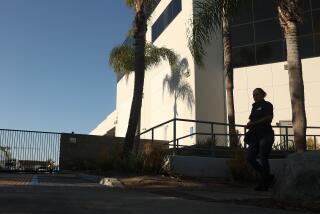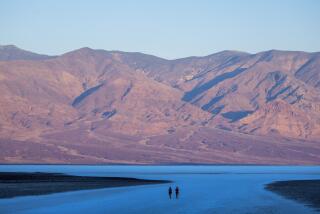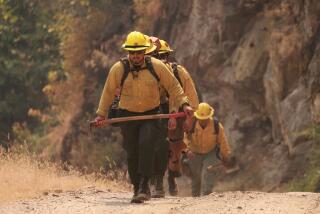Adding to the Heat of Battle
Clad in an ensemble of ripstop cotton, Velcro and carbon-impregnated cloth, Army Sgt. Kerrethel Avery was feeling a bit hot and shaky under the bank of television lights.
She was modeling the Armyâs new chemical and biological protection suit for a group of reporters when she suddenly began to totter. As she tumbled off the platform into a row of chairs, her comrades lunged to her rescue, unzipping their own suits to reveal more sweaty and flushed faces.
âWhy donât you guys go ahead and stand at ease, take it easy,â Lt. Col. George Lecakes told the troops as they revived Avery. âThose lights are pretty hot.â
If U.S. forces find themselves under attack by chemical or biological weapons in the Iraqi desert, these unwieldy suits could mean the difference between life and death.
Known as joint service lightweight integrated suit technology, or JSLIST, each suit weighs just 6 pounds. It uses a semi-permeable material to release heat and moisture, much like the Gore-Tex fabric used by campers and hikers. A layer of tiny carbon spheres stands ready to absorb toxic gases and disease agents such as anthrax, sarin gas and smallpox.
Yet for all its futuristic features the JSLIST remains remarkably primitive in its attempt to balance comfort, convenience and protection. The result is a quirky mixture of contradictions, even when the suits are in perfect condition and used exactly as designed.
Soldiers can drink in the suits but not eat. They can go to the bathroom, but it takes at least one buddy to help unfasten the safety seals in order to empty oneâs bladder. The JSLIST protects against most toxic agents, but once exposed it is good only for 24 hours. Defense officials say they have two JSLIST suits for every soldier and sailor deployed in the gulf region.
The single greatest problem, experts say, is the suitâs difficulty in âbreathingâ out heat and sweat. The situation gets worse when body armor and other equipment are layered on top.
Wearing full-body protective gear can add 10 degrees or more to the perceived ambient temperature. At 90 degrees, troops in the suits rapidly confront the limits of human biology.
(Forecasters expect the temperature in Baghdad today to reach 100 degrees. Soldiers deployed outside the city have been wearing JSLIST suits, though not masks.
But on Friday, numerous units reported being allowed to take off their suits for the first time in 15 days, with reporters citing heat as a factor.)
The Armyâs environmental institute recommends that for every 10 to 15 minutes of combat training while wearing the chemical suits and masks, soldiers rest for 45 or 50 minutes if temperatures exceed 80 degrees.
âThe image of soldiers all dressed up in these suits, then conducting a four-hour firefight -- this is not going to happen,â said Al Davies, director of the Critical Care Medicine Training Program at Baylor College of Medicine and an expert in heat stress.
Stifling Suits
Heat has bedeviled the militaryâs chemical specialists ever since they developed gas masks during World War I. The crude and stifling flannel hoods, equipped with celluloid-covered eyepieces, were impregnated with chemicals to resist clouds of chlorine and mustard gas that drifted over the front lines and settled into the trenches of World War I.
In the heat of battle the eyepieces would cover with steam, and frantic breathing built up dangerous levels of carbon dioxide. Sweat released the chemical agents that had stuck to the flannel mask, burning the soldiersâ faces and necks.
Dramatic improvements in technology, including the development of synthetic materials during World War II, led to better-fitting masks with more efficient filters. But the preparations proved unnecessary. Although Germany developed an arsenal of highly potent nerve gases, there was no large-scale chemical or biological warfare except for Japanâs dropping of plague-infected wheat and rice on Chinese civilians.
The golden age of gas and germ production came during the Cold War. Both the Americans and the Soviets amassed vast arsenals. Soldiers trained in heavy masks attached to ghoulish-looking, rubberized, full-body suits that protected against toxic agents, but they proved cripplingly cumbersome.
The torturous outfits reinforced the lessons of the early masks: Heat is as much an enemy as poison.
The JSLIST, developed in 1997, looks and feels like an ordinary, insulated military uniform -- a simple hooded jacket and pants with cargo pockets.
If uncontaminated, the surprisingly light suit can be worn for as long as 45 days and can be laundered as many as six times.
Its Velcro straps, string ties and elastic edges are reminiscent of sports gear, but at $210, the JSLIST jacket-and-pants combination costs only a third as much as some ski jackets.
The suit -- available in navy blue and multicolor camouflage for either deserts or forests -- fits snugly over a regular uniform; a hood flips over a gas mask and the arm and leg cuffs seal over boots and gloves. The suitâs outer layer resists water, oil and toxic dangers; the activated-carbon lining is designed to absorb any toxic agents that manage to get through, while allowing some body heat to escape.
âOur commanders understand what heatâs all about, and they understand what heat stress is all about,â said Brig. Gen. Steve Reeves, the Defense Departmentâs executive officer for chemical and biological defense.
A Modular System
The JSLIST and the rest of the protective ensemble are a modular system, designed to be pulled on as needed depending on the threat level. Everything depends on what the military calls the âmission-oriented protective posture,â or MOPP, level.
MOPP1 corresponds to a possible but not imminent threat. Soldiers wear the jacket and pants but carry the hood, mask, gloves and boots. For MOPP2 -- when a chemical or biological attack is deemed probable -- the protective over-boots are then pulled on. When toxic agents are detected at low levels, a MOPP3 alert requires soldiers to don the mask and hood, still carrying the gloves. The gloves are added at MOPP4, when the environment may be badly contaminated.
All troops in the gulf region carry a suit at all times -- even sailors are required to wear olive-green pouches containing the JSLIST. On the aircraft carrier Abraham Lincoln, they are called âWilsons,â after Tom Hanksâ omnipresent Wilson volleyball sidekick in the film âCastaway.â
Comments such as, âIâm getting a bruise from my Wilson,â or, âI canât wait to get rid of my Wilsonâ are commonly overheard from sailors tired of carrying them around.
Lugging a Wilson around is only a minor inconvenience compared with the headaches of actually working in one.
Female troops are in a particularly bad spot. Lt. Suzanna Cigna, aboard the Abraham Lincoln, said women have been told by trainers that the suit is not designed to allow them to urinate without risking exposure to outside contaminants. On the other hand, if they relieve themselves while in the suits, the urine destroys the protective carbon lining.
âI guess weâre just supposed to hold it,â Cigna said.
Troops faced with MOPP4 conditions would be moved to a safer location as soon as operationally feasible, said Lt. Col. Daniel Murray, executive officer of the U.S. Army Chemical School at Ft. Leonard Wood in Missouri. But they are expected to function in full protective gear for at least six hours, and have trained to do so, he said.
Thatâs difficult for Cigna to fathom.
âAfter half an hour, I was so drenched in sweat that there were puddles in my boots and the fingertips of my gloves,â she said of her time training in the suit. âI canât imagine what it would be like for hours or days.â
The implications of the heat problem can be ominous.
If the core body temperature rises too much, it âposes the risk of major arrhythmia [irregular heart beat] or cardiac arrest,â said Davies, the heat expert at Baylor. âThe same sort of difficulties arise in the brain, [leading to] giddiness, sometimes hallucinations, sometimes profound weakness or fatigue,â and ultimately collapse.
If troops in toxic areas do light work, such as monitoring a position and occasionally firing a weapon, they can go on as long as a few hours, according to Tom McLellan, an exercise physiologist with Canadaâs Defense Research and Development division and one of the leading experts on chemical protection equipment.
Vigorous activity -- carrying heavy gear, running, or loading and firing heavy weapons -- is possible for no more than 35 to 40 minutes while clad in a full chemical suit, according to McLellan. On the battlefield, adrenaline could extend that performance by a few minutes, but after that, he said, âtheyâll fall down, they wonât be able to continue.â
Bernard J. Fine, a former research psychologist at the Armyâs environmental medicine institute, said that many soldiers forced to wear such suits experience respiratory stress caused by the air resistance of mask valves.
They also can suffer from claustrophobia and a sense of isolation because they canât see a buddyâs facial expression or hear his voice clearly.
On top of that, it may be hard to distinguish military officers from privates because troops in full-body chemical suits tend to look alike.
âWearing chemical protective clothing while under enemy fire in a hot ambient temperature is a stress of the very highest order,â Fine wrote in a recent article published on the Web site Globalsecurity.org.
If toxic weapons are used, U.S. forces may still be able to fight effectively if they can replenish troops frequently and quickly, some experts say. The military points out that many troops now in Iraq have trained in the Mojave Desert and are acclimated to Iraqâs desert conditions by now.
But even that may not be enough, said Phillip A. Bishop, an investigator at the human performance laboratory of the University of Alabama, who has studied the experience of wearing chemical suits for nearly two decades.
âThe gung-ho military attitude is that with sufficient motivation you can do anything,â he said. âBut you canât beat physiology and you canât beat physics.â
*
Times staff writer Carol J. Williams, aboard the U.S. aircraft carrier Abraham Lincoln, contributed to this report.
More to Read
Sign up for Essential California
The most important California stories and recommendations in your inbox every morning.
You may occasionally receive promotional content from the Los Angeles Times.










